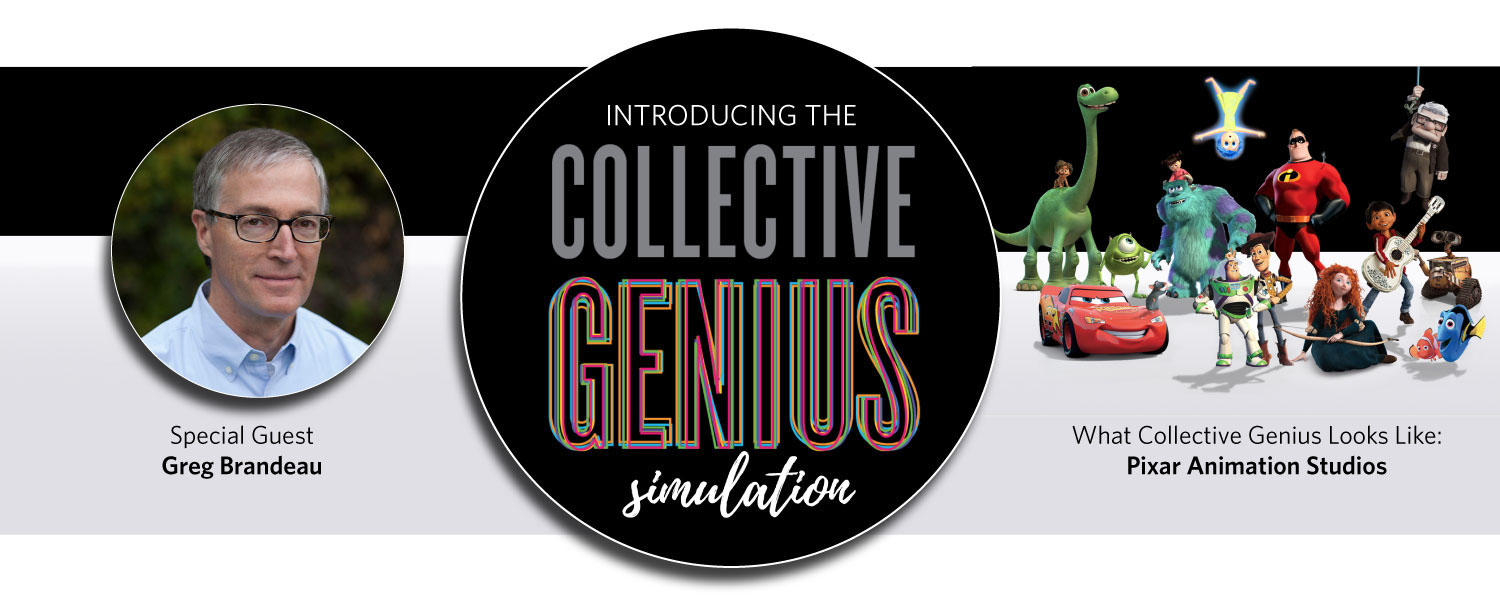
Pixar stories and other insights on innovation from ‘Collective Genius’
In this recap of our recent preview event, 'Collective Genius' co-author Greg Brandeau, a former Pixar and Disney executive, shares stories about how Pixar was able to create 5 blockbusters in a row - a feat that had never been done before – and how what they did at Pixar also helped spark innovation at Disney Animation. Learn those strategies and more in the Collective Genius simulation, which is helping leaders from all industries nurture a culture of innovation.
The Collective Genius approach to solving problems creates a safe space for teams to explore, discover, and identify solutions that will have a lasting impact at both the local and organization level."
- Participant feedback from Ron Keith, The Christ Hospital Health Network
These stories highlight some of the origins of innovation at Pixar and Disney.
When a creative artist and computer scientist had to share an office at Pixar:
At Disney, helping everyone mix and mingle:
Bonus stories!
Greg shared these during our practice session:
Creating an environment for innovation at Pixar meant finding ways for everyone to take part (and be listed in the credits). Highlight: Greg's assistant brought in her own wedding dress to help animators create one for Mrs. Incredible. (3:00):
A peek at Mrs. Incredible's wedding dress, modeled after the one Greg's assistant brought in:
Pixar had all the animators review everyone's work every day so they could all learn from each other. Highlight: How one animator determined the little green army men in Toy Story needed to move with their feet stuck together was a lesson from which everyone in the studio was able to benefit (6:20):
The result: Here's how the little green army men moved in Toy Story based on an animator's experiment in the studio.
When Disney bought Pixar for $7.6 billion in 2006, they were hoping to reignite their animation division.
"Disney Animation had started making movies that were terrible," under-performers like Home on the Range and Chicken Little, recalled Greg Brandeau, who was a Pixar executive at the time. Meanwhile, Pixar had knocked out one blockbuster after another: Toy Story, Finding Nemo, The Incredibles, and Monsters, Inc., to name a few.
A world without Frozen?
Executives Bob Iger, Steve Jobs, and John Lasseter briefly even considered shutting down Disney Animation, Brandeau said, but decided they had to try to fix it to preserve an icon of the movie world.
It's no secret that they succeeded. Both studios of 700-800 people survived the merger, only about 10 people were let go, and Disney Animation endured to thrive again, eventually producing some of its biggest hits, including Zootopia and Frozen.
How did they do it?
Part of the magic was in their discovery of key differences in the way the two studios were organized and how people there were able to spontaneously interact (or not).
Pixar's success stories, and similar achievements in other industries (including pharmaceuticals, automotive, high-tech companies, and others) and geographies where innovation saved the day, are among those retold in Collective Genius: The Art and Practice of Leading Innovation, an award-winning book Brandeau reseached and co-wrote with Harvard Business School Professor Linda Hill and two others to discover and document the secrets behind organizations able to innovate again and again.
Their book is the foundation for a new interactive simulation and learning journey available from Advantage Performance Group through our thought leader partners at Paradox Strategies, a company Dr. Hill and Brandeau founded to apply their research in the corporate world.
During an exclusive preview of the Collective Genius simulation, Brandeau shared Pixar stories and participants got a taste of how their decisions as leaders can contribute to or reduce their chances for successful innovation.
In the Collective Genius simulation ...
In the Collective Genius simulation, leaders learn a framework for innovation that provides practical ways they can nurture an environment in which people are both willing and able to do the hard work that innovation requires, starting with shared values, a shared sense of purpose, and rules of engagement. They must also foster opportunities for teams to experience creative abrasion, creative agility, and creative resolution, the catalysts for innovation that are supported by 9 imperatives, while also navigating a continuum of paradoxes to both harness and unleash collective genius.
Watch our replay
Register below to immediately access the replay from our preview event hosted by Advantage strategist and senior partner Richard Hodge, who also teamed up with Paradox to lead the simulation design. Please note the replay does not include the decision scenarios discussed in breakout sessions, but an Advantage partner would be happy to walk through those with you if you are considering bringing Collective Genius to your organization.
Additional insights and discussion
The Collective Genius research comes from multiple industries and geographic areas.
Creating spontaneity in the Zoom era:
Like polishing a diamond: The importance of creative abrasion:
Dealing with different points of view:
Go to the replay
- Advantage named to 2024 Leadership Training Watch List - April 11, 2024
- Multipliers + Collective Genius: A perfect pair for creating innovative, capable teams - January 8, 2024
- Innovation, defined: ‘It’s everyone’s job to contribute’ - December 12, 2023

